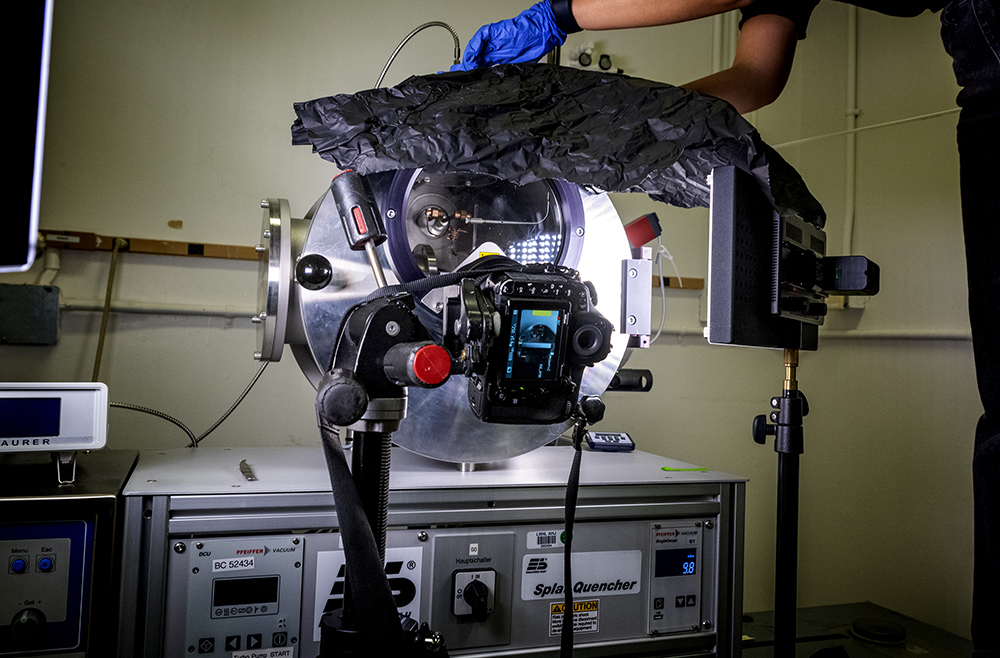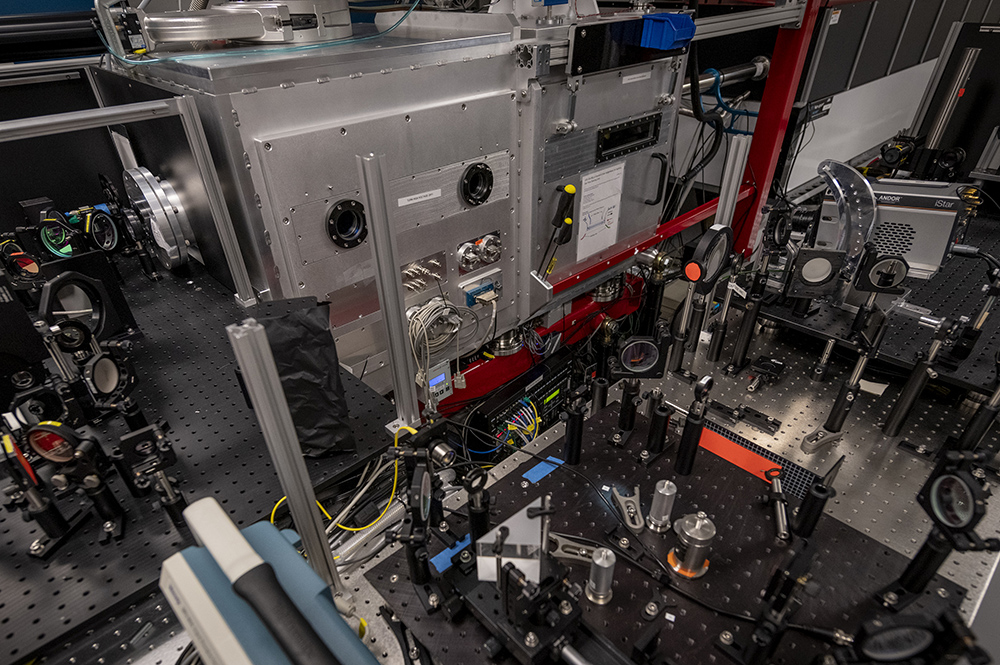Despite the challenges presented by working remotely, Berkeley Lab staff continue to support the Lab’s mission of innovation and team science. These challenges have prompted changes not only in how staff work and what methods are used, but have also presented new opportunities to rethink how we document and share the Lab’s work with the world. This ongoing series features collaborations with Thor Swift, Lead Photographer, Creative Services Office/IT, and describes the methods and the collaborative process utilized to document and illustrate work ranging from multidisciplinary scientific research to operations infrastructure and equipment upgrades.
Thor joined the Lab in 2019 and is a member of the Creative Services Office of the Information Technology (IT) Division. Creative Services offers a comprehensive range of services in visual communications and resources to support Berkeley Lab’s mission. A team of experts is available to work with researchers to communicate science, including advanced photography and videography capabilities offered by Swift. Photo and video services available to all Berkeley Lab staff include studio portraits, in-person or virtual events, tours, aerial photography and video, photo and video editing, documentation of work in progress, video recording, and more. Creative Services is available to help communicate the important work being done by everyone at Berkeley Lab.
The collaborative nature of team science is communicated utilizing advanced imaging techniques, software, and cameras. Innovations in optics and imaging technologies, especially photo and video editing software, allows for much greater creative freedom and enables innovative possibilities in documenting research and science communication. The examples below focus on recent examples of the scientific progress documented by Thor in collaboration with the scientists who conduct the research.
Silicon Consortium Project Splat Quencher Video

Videography projects can aid in understanding and communicating science to other researchers and to the public. In this example, Thor worked closely with Hyungyeon Cha, Postdoctoral Researcher in the Kostecki Lab, to record a new method to synthesize Si-based metallic glass thin foil, part of a process related to the Silicon Consortium Project, a national laboratory collaboration funded by the U.S. Department of Energy’s Vehicle Technologies Office. In addition to Berkeley Lab, the consortium includes Argonne, National Renewable Energy, Sandia, Oak Ridge, and Pacific Northwest Laboratories.
The effort at Berkeley Lab is led by Robert Kostecki, Senior Scientist and Division Director of the Energy Storage and Distributed Resources (ESDR) Division in the Energy Technologies Area (ETA), and including Gao Liu, Leader of the Applied Energy Materials Group, and Vassilia Zorba, Leader of the Laser Technology Group and Associate Adjunct Professor in the Department of Mechanical Engineering of the University of California, Berkeley.
“The purpose of this video was to increase the understanding of the machine, which is quite a novel synthesis method in lithium ion batteries research. Splat quencher quenches molten alloys using cold metal surfaces on the order of 105 -106 K/s to produce amorphous metallic glass thin foils. We are making Si-based amorphous metallic glass thin foils for the next-generation lithium-ion battery anode materials. Since molten alloys drop so quickly, we needed to find a way to capture the falling motion and splatting process.
Collaborating with Thor helped a lot. After several trials, we captured the motion (synthesizing metallic glass thin foil) that we intended to show. We used this video in a past presentation for the ‘Silicon Consortium Project’. Also, we will hopefully use this video in the future paper.”
Hyungyeon Cha, Postdoctoral Researcher, Energy Storage & Distributed Resources Division, Energy Technologies Area

The action the video needed to show occurs inside the vacuum chamber and the glass on the chamber door was too reflective to see the action inside the chamber. Additionally the interior of the chamber was lit only by the ambient room light through a small window on the top of the device.

In order to light the inside of the chamber, two LED lights were placed on either side of the device. Unwanted reflections were reduced by placing black foil around the top of the device.
The camera and light set up needed to be in the location where a researcher would normally stand, which meant Hyungyeon had to use the top window to view the vacuum chamber and activate the dropping of the material.

Thor took part in the activation process by stepping on a pedal which Hyungyeon could not reach from her new location, while simultaneously working the camera controls. There was some trial and error to get the timing right but after a few failed attempts they were able to capture the action inside the chamber.
The camera was set to record at 4 times normal speed at a high frame capture rate. In the editing process the video was slowed to normal playback speed which resulted in a smooth slow motion video playback.
Berkeley Lab Laser Accelerator (BELLA) World Record Results in HDR
On a project for the Berkeley Lab Laser Accelerator (BELLA) Center, Thor worked with Marlene Turner, Research Scientist, and Anthony Gonsalves, Staff Scientist, to capture precise High Dynamic Range (HDR) images of important new results, described in detail by ATAP and published in the journal, High Power Laser Science and Engineering. A postdoctoral scholar at the start of the project, Marlene is now a career track scientist, and both researchers are members of the Accelerator Technology & Applied Physics (ATAP) Division, Physical Sciences Area. The photos highlight another example of how a scientific project can be aided by collaboration between scientific researchers and operations staff on both hybrid and remote work teams.
“First thank you for choosing us. We are quite honored that you thought this was a fruitful collaboration. The photos had to be taken at that time because the journal wanted to highlight our article on their website with a lay person’s description of the work and its impact, as well as some compelling photographs.
The capillary shown in the photos is used for keeping laser pulses focused and intense over long distances. Usually a focused laser pulse diffracts (gets larger and less intense) as it propagates. Keeping it intense over long distances has a number of applications, and the one we have focused on is laser plasma acceleration. In this case it allows particle acceleration in this type of device over longer distances, which means the particles can gain more energy. We currently hold the world record for highest energy in a laser plasma accelerator!”
Anthony Gonsalves, Staff Scientist, BELLA Center Associate Director for Experiments
Several elements of the experiment room posed interesting challenges to creating the desired results. The lights in the room needed to be off so the ambient light would not over power the light from the capillary. Even so, the glow of the capillary was dim and the contrast range was greater than the camera could capture in a single exposure.


The other difficulty in making this photograph is a common one at Berkeley Lab, as many rooms are often filled with delicate scientific equipment, with little space remaining for setting up necessary photography tools. The set up for these photographs had to be squeezed into a very tight space between the equipment table and the location of the capillary, without disrupting the equipment.
After stabilizing the camera on a tripod, multiple exposures were made with a range of exposure times from 1/15th of a second to 2 seconds in order to capture a wide dynamic range. The images were then combined using Adobe Lightroom to create a single composite HDR photo. Further editing was done in Photoshop to selectively add or remove light from parts of the image to fully realize a compelling image of the plasma glow in the vacuum chamber.
Look forward to the next part of this series in a future IT newsletter, describing how advanced photography capabilities helped Berkeley Lab facilities resolve the difficulties encountered with major projects including remote communication while moving large work vehicles, mapping underground utility lines without requiring the presence of onsite contractors, and the use of aerial photography to aid the mapping of underground utilities for the cafeteria renovation.
Current Services
The Creative Services Office is available as a resource for the entire Berkeley Lab community, providing expertise in many areas related to visual communication, technical writing and editing, photography, web development, printing, and videography.
- Visit creative.lbl.gov.
- Contact the Creative Service Office to request support or initiate inquiries.
- Learn more about Working with Creative Services.
- Design, illustration, web, photography, video and printing services: $127 per hour. View Information about Rates and Billing.
- Submit a Project Request Form.
Quick Links
- For general questions or technical support email help@lbl.gov or visit help.lbl.gov.
- Contact IT Communications at itcomms@lbl.gov for corrections, feedback, or suggestions for future topics.

